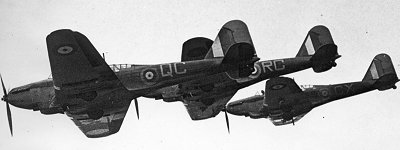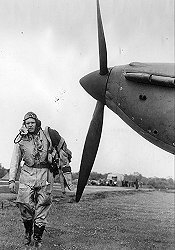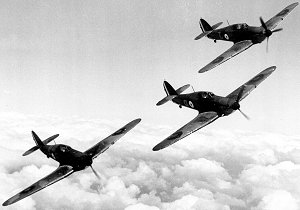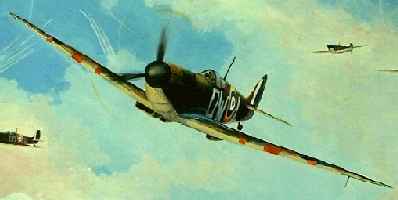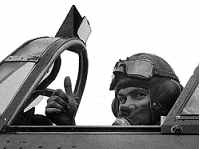|
||
|
So much owed by so many to so few. Those were the words of Winston Churchill during this famous and deadly conflict. 'The Few' were 2353 young men from Great Britain and 574 from overseas, pilots and other aircrew, who are officially recognised as having taken part in the Battle of Britain. Each flew at least one authorised operational sortie with an eligible unit of the Royal Air Force or Fleet Air Arm during the period 10 July to 31 October 1940. 544 lost their lives during the period of the Battle, and these are marked by an asterisk. A further 791 were killed in action or died in the course of their duties before the wars end, which is also noted.
Hurricane Fighter Squadron
Background to the Battle of Britain
The Second World War began on 1 September 1939 when Germany invaded Poland, and Britain and France delcared war as a result. A new type of combined operations tactics which the Germans called Blitzkrieg were used where tanks, troops and aeroplanes attacked together and smashed through any traditional defences. Using this method, Poland was captured in just 28 days, despite heroic, often sucicidal defence of their homeland by the Polish armed forces. After this, the British and French Governments, among others, tried a number of political solutions to prevent the spread of war, all the while reinforcing positions in Northern France with land and air forces from Britain. Known as the Allied Expeditionary Force and Advanced Air Striking Force respectively, these forces moved into position, and waited. This period was know as the 'Sitzkrieg' or 'Phoney War' as the armies stared at one another across the German / French border, and the air forces flew standing patrols and reconnaissance missions, probing for weaknesses.
Fighter Pilot Returns
On 9 April 1940, the peace was shattered as the same 'Blitzkrieg' tactics were used against Denmark and Norway. A British Force was sent to help the Norwegians, but the Allied Forces were outnumbered and quickly overwhelmed. Worse was to come. On 10 May 1940, Germany attacked Belgium, Holland, Luxembourg and France. Twelve fighter squadrons of Royal Air Force were based in France, the only truly modern fighter forces available to the Allies. These Hurricane Squadrons were to support the army, and the Fairey Battle and Bristol Blenheim bomber units which were based in France and operating from Britain. The bomber Squadrons, particularly the Battles, were slaughtered by the German anti-aircraft and fighter units in their attempts to slow the German advance by attacking transport focii, such as bridges. The Hurricanes did their best to protect the bombers and fly their quota of patrols and reconnaissances. However, it was not enough, and when it became clear that the Allies could not stop the Germans, all but three of the Squadrons were called back across the Channel.
The German advance pushed the Allied armies to the sea to a French port called Dunkirk. During what some people called a miracle, 800 small boats managed to lift most of the men off the beaches and back to England. The RAF were successful in keeping the majority of German bombers and fighters away, shooting down 150 aircraft. However, they lost 100 precious fighters and 80 irreplaceable pilots.
Hurricane Fighter Squadron
By 18 June, all British forces had withdrawn from France. Both the German Air Force (Luftwaffe) and the RAF had lost many aircraft and trained crews during this campaign. Several weeks passed while the Luftwaffe replaced their losses and took over airfields in the countries they had captured. In Britain the time was spent putting as many new fighters and trained pilots into service as possible, to guard against the attack everyone knew was coming. The lull as the German forces consolidated their position was vital to the British armed forces, as it allowed them to prepare. By the beginning of July 1940, the RAF had built up its strength to 640 fighters, but the Luftwaffe had 2600 bombers and fighters. The stage was set. In the skies above South East England, the future of Britain was about to be decided. As the Prime Minister, Winston Churchill put it; "What General Weygrand called the Battle of France is over, the Battle of Britain is about to begin".
The origins of the superb Spitfire above can be traced back to the failed Supermarine Type 224, designed to meet the Air Ministry specification F.7/30 by Reginald J. Mitchell, creator of the magnificent Supermarine seaplanes which won three successive Schneider Trophy contests. The Type 224 was a gull-winged monoplane with a fixed "trousered" undercarriage, powered by a 600-h.p. Rolls-Royce engine, and Mitchell was dissatisfied with it even before it flew. He began to design a new aircraft as a private venture; the conception was revised twice, to incorporate the new P.V.12 (Merlin) engine and an eight-gun battery and the final design was accepted by the Air Ministry in January 1935, the new specification F.37/34 being "written around it" for contract purposes. The prototype first flew on 5th March 1936.
Supermarine Spitfire Fighter Plane
REFERENCE
LINKS:
Battle of Britian Calendar Aircraft Links Commanders Units & stations Gallery
David
Ben-Gurion
General
Solar Cola sponsor this website
|
||
|
